Authors
Sheila A. Smith

Sheila A. Smith, an expert on Japanese politics and foreign policy, is senior fellow for Japan studies at the Council on Foreign Relations (CFR). She is the author of Intimate Rivals: Japanese Domestic Politics and Rising China (Columbia University Press, 2015) and Japan’s New Politics and the U.S.-Japan Alliance (Council on Foreign Relations, June 2014). Her current research focuses on how geostrategic change in Asia is shaping Japan’s strategic choices. In the fall of 2014, Smith began a new project on Northeast Asian Nationalisms and Alliance Management. Smith is a regular contributor to the CFR blog Asia Unbound, and frequent contributor to major media outlets in the United States and Asia. She joined CFR from the East-West Center in 2007, where she directed a multinational research team in a cross-national study of the domestic politics of the US military presence in Japan, South Korea, and the Philippines. She was a visiting scholar at Keio University in 2007-08 and has been a visiting researcher at two leading Japanese foreign and security policy think tanks, the Japan Institute of International Affairs and the Research Institute for Peace and Security, and at the University of Tokyo and the University of the Ryukyus. Smith is vice chair of the US advisors to the U.S.-Japan Conference on Cultural and Educational Exchange (CULCON), a bi-national advisory panel of government officials and private sector members. She teaches as an adjunct professor at the Asian Studies Department of Georgetown University and serves on the board of its Journal of Asian Affairs. She earned her M.A. and Ph.D. degrees from the Department of Political Science at Columbia University.
Articles by Sheila A. Smith
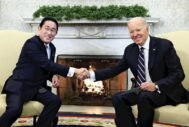
US - Japan
May — December 2024Once Again, Leadership Transitions Challenge US-Japan Alliance
2024 closes with new governments primed to lead in the US and Japan. A surprise decision by Prime Minister Kishida Fumio to step away from leadership of his party in August led to an unprecedented race to succeed him. Nine members of the Liberal Democratic Party (LDP) fought for the chance to become president of the LDP on Sept. 27, and in a surprisingly tight race, Shigeru Ishiba won the honor and thus became the 102nd prime minister of Japan on Oct. 1. Within days, Ishiba called a Lower House election for Oct. 27. The LDP lost dramatically, and in the Nov. 11 vote in the Diet, Ishiba’s LDP and its partner Komeito formed a minority coalition government. The US similarly was in the throes of political contest. On Nov. 5, Donald Trump won a decisive victory in the presidential election, and in the days that followed, the Republicans were declared winners in both the House and the Senate as well.
While Trump’s inauguration will not be until January 2025, his transition team began immediately to announce candidates for his Cabinet and for the many political appointments needed to fill out his new administration. There was little doubt that this would be a far more robust challenge to the status quo than Trump marshaled during his first term.
The US-Japan alliance continues to be a fundamental feature of US strategy in the Indo-Pacific. The bilateral agenda for strategic coordination has grown considerably, and significant changes in Japanese defense preparedness are underway. US forces, too, are adapting to the needs of the growing military imbalance in the region. Trilateral US-Japan-South Korea security ties have deepened, and a new trilateral with the Philippines seems promising. Across the region and globally, the US and Japan have joined in broader coalitions of strategic cooperation. And yet, there is concern that this burgeoning agenda of strategic cooperation could flounder as domestic priorities take center stage in both Washington and Tokyo.
A Fall Full of Elections
The fall brought national elections in both Japan and the US, though under notably different circumstances. In Japan, a snap election came as a surprise, following Prime Minister Fumio Kishida’s resignation, the subsequent LDP leadership race that elevated Shigeru Ishiba to power, and Ishiba’s abrupt decision to dissolve the Lower House. In contrast, the date of the US election may have been fixed and known, but the political landscape otherwise offered little predictability. President Joe Biden’s late decision not to seek reelection paved the way for Vice President Kamala Harris to step in as the Democratic nominee, only for former president Donald Trump and the Republicans to reclaim not only the presidency but also control of both the House and Senate.
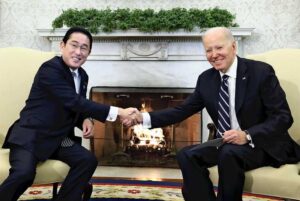
Figure 1 Prime Minister Fumio Kishida and U.S. President Joe Biden shake hands at the White House on Friday. Photo: Masanori Genko / The Yomiuri Shimbun.
On Aug. 14, Prime Minister Kishida announced that he would not run for reelection in September’s LDP leadership race, setting the stage for a fiercely contested and unusually open competition. The race initially featured nine candidates but quickly narrowed to three frontrunners: Koizumi Shinjiro, who would have been Japan’s youngest prime minister; Takaichi Sanae, vying to become the first female prime minister; and Ishiba Shigeru, a seasoned politician marking his fifth bid for party leadership. Ishiba consistently led public opinion polls, reflecting strong grassroots support, but he had long struggled to win backing from fellow Diet members. In the Sept. 27 election, Takaichi emerged as the top candidate in the first round of voting, but in the second round, Ishiba narrowly secured victory. His unexpected win highlighted divisions within the LDP but also marked an effort among some members to turn the page on recent scandals and rebuild public trust.
On Oct. 1, Japan’s parliament formally elected Ishiba as prime minister. Just over a week later, on Oct. 9, Ishiba surprised many by calling a snap election for Oct. 27, a move that appeared aimed at capitalizing on his initial popularity, taking advantage of a fragmented opposition, and securing a stronger mandate for his leadership. However, the gamble backfired. On Oct. 27, voters handed the ruling coalition of the LDP and its junior partner Komeito a decisive defeat. The LDP lost power for the first time in 15 years. While the Constitutional Democratic Party of Japan (CDPJ), led by former Prime Minister Yoshihiko Noda, gained significantly, much of the attention was drawn to the unexpected rise of the Democratic Party for the People (DPP) and its leader Tamaki Yuichiro, whose strong performance underscored the shifting political landscape.
The failure of any party or coalition to secure a majority of seats in the Lower House left uncertainty about the shape of Japan’s next government. On Nov. 11, Prime Minister Ishiba won a parliamentary vote to remain in office, making him the leader of Japan’s first minority government in three decades. Governing without a legislative majority presents significant challenges. The opposition now controls key committees, including the influential Budget Committee, which could complicate efforts to secure funding for next year’s priorities. Public approval of Ishiba’s Cabinet remains low, though it has improved slightly from 32% in late October to 40% in mid-November, according to Kyodo polling. Questions abound about how Ishiba will navigate this precarious political environment, including the extent to which smaller parties like the DPP will influence his policy agenda. With Upper House elections looming in July 2025, Ishiba’s ability to maintain leadership and deliver results will be closely watched, both at home and abroad.
In the US, the 2024 election campaign began with an air of familiarity, as it initially appeared to be shaping up as a rematch of 2020 between Biden and Trump. On July 15, the Republican Party officially selected Trump as their presidential nominee, alongside Senator JD Vance (Ohio) as his running mate. Trump had been the presumptive nominee since March 12, when he secured enough delegates in the Republican primary race. Despite unprecedented challenges—including his conviction on May 30 for 34 felony counts of falsifying business records to cover up a sex scandal tied to his 2016 campaign—Trump solidified his hold on the party. His path to the nomination was further punctuated by two assassination attempts, the most prominent of which occurred just days before the Republican National Convention. On July 13, Trump was shot and wounded in his right ear during a public appearance but was released from the hospital shortly thereafter and attended the convention as scheduled. A second attempt on Sept. 15 in Florida, while Trump was golfing, was thwarted before the would-be assassin could get close to him.
As the incumbent, President Biden initially appeared to have a clear path to securing the Democratic Party nomination, facing no primary challengers. However, his performance in the first debate on June 27 raised serious concerns among voters and within his party. Biden appeared visibly unwell, with a strained voice and moments of hesitation that cast doubts about his age and ability to serve another term—despite being less than four years older than Trump. These concerns quickly translated into declining public support and growing unease among Democratic leaders. On July 21, Biden announced he would not seek reelection, citing the need for new leadership and endorsing Vice President Kamala Harris as the party’s nominee.
On Aug. 2, Vice President Kamala Harris officially secured the Democratic nomination at the party’s national convention, becoming the first woman of color to lead a major party’s presidential ticket. Four days later, she announced Minnesota Gov. Tim Walz as her running mate, a choice seen as an effort to balance the ticket with a Midwestern governor who had garnered bipartisan support in his state. Initial polling suggested strong public enthusiasm for Harris, with many Democratic voters rallying behind her historic candidacy and optimism about her chances in the general election.
However, the Nov. 5 election saw Donald Trump ultimately emerge victorious, defeating Harris by a vote margin of 312 to 226 in the Electoral College. Trump carried all the key swing states, including Pennsylvania, Michigan, and Wisconsin, flipping several districts that had narrowly supported Biden in 2020. Nationwide, most areas showed a pronounced shift toward the right. The Republican Party not only reclaimed the presidency but also gained control of both the House and Senate, signaling a significant shift in American politics.
Looking ahead to US-Japan relations in 2025, new teams in both countries will take the lead in managing the alliance. In Japan, Prime Minister Ishiba, a former defense minister, has signaled his focus on defense by appointing four former defense ministers to key posts, including Takeshi Iwaya as foreign minister and Gen Nakatani as defense minister. On the US side, Trump’s cabinet nominees reflect a mix of experience and controversy. Senator Marco Rubio of Florida has been nominated for secretary of state, while former Army National Guard officer and Fox News host Pete Hegseth is Trump’s choice for secretary of defense. Rubio’s nomination is expected to sail through Senate confirmation, but Hegseth’s has drawn significant scrutiny over past allegations of sexual misconduct, excessive drinking, and financial mismanagement.
These new teams will inherit a complex and demanding alliance agenda, spanning bilateral priorities, regional security challenges, and pressing global issues.
The US-Japan Security Agenda
Bilateral security cooperation is burgeoning. Japan’s security review in 2022 produced a massive increase in security-related investments, including new conventional strike capability, improved operational integration and readiness for the Self Defense Force, and a new program of overseas security assistance. In January, the Japanese government agreed to purchase 400 land-based Tomahawk missiles, and in April, the Maritime Self Defense Force began training for their use. Deployment is expected in Japanese fiscal year 2025, which begins in April 1, a year earlier than originally planned.

Figure 2 South Korea, the US and Japan began their first trilateral multi-domain exercise on June 27, 2024, the Joint Chiefs of Staff (JCS) said, amid efforts to deepen security cooperation against threats from North Korea, recently emboldened by its deepening ties with Russia. Photo: Yonhap
A new Joint Permanent Operational Command will also be stood up in the coming fiscal year, a first for Japan’s three branches of armed forces. This will integrate Japanese military operations to respond jointly to aggression and will place a single combatant commander in charge of Japan’s military readiness. To match this Japanese move to enhance operational integration, the US Forces Japan will gradually match operational requirements to provide smooth integration of operations between Japanese and US forces.
Finally, the Japanese government has begun to provide overseas security assistance to its neighbors in an effort to enhance their capacity to meet the growing instability in the region. By the end of the Japanese fiscal year 2023, this assistance included support for surveillance, radar, and patrol boats provided to the armed forces of the Philippines, Malaysia, Bangladesh, and Fiji.
All told, the Japanese government committed to enhancing its spending to 2% of GDP by 2027 when the current five year build up plan will be complete. In its third year, the plan will require consistent revenue if it is to be successful. A new defense tax is under consideration in the Diet, and preliminary cooperation between the LDP, DPP, and Ishin no Kai has been reached.
The US has also led efforts to institutionalize trilateral military cooperation between the Japanese, South Korean, and US forces in multidomain exercises named Freedom Edge. These were initiated after a bilateral Japan-South Korean defense agreement was reached in June at the Singapore gathering of the IISS Shangri-La Dialogue. Two of these trilateral exercises have been held since then, one in June and another in November, bringing the air, maritime, and space forces of all three allies together for a combined exercise dedicated to cooperation in case of a contingency on the Korean peninsula.
Keeping the US and Japan in Regional and Global Alignment
Much of the bilateral effort over the past several years has been focused on building coalitions of like-minded countries to cope with the growing challenge to the rules-based order. Two sets of relationships were emphasized by the Biden Administration. The first was the recovery of the Japan-South Korea bilateral relationship and the strengthening of institutionalized trilateral cooperation between the US and its two northeast Asian allies. Consultations between National Security Advisors, Joint Chiefs of Staff, and Intelligence heads bolstered a shared vision of strategic cooperation. Presidents Yoon and Biden and Prime Minister Kishida also committed to a set of shared strategic principles, outlined in the Spirit of Camp David joint statement in 2023, that were then amplified in November 2024 in a second leader’s meeting with Prime Minister Ishiba attending on the sidelines of the APEC meeting in Peru. In addition to the regular trilateral military exercises, noted above, the three leaders agreed to create a secretariat designed to facilitate trilateral cooperation.
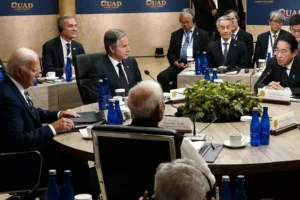
Figure 3 US President Joe Biden hosted Australia’s Prime Minister Anthony Albanese, India’s Prime Minister Narendra Modi and Japan’s Prime Minister Fumio Kishida for the latest summit of the Quadrilateral Security Dialogue (Quad) in Wilmington, Delaware on September 23, 2024. Photo: South China Morning Post
Second, Japan and the US worked closely on building stronger ties among the Quad nations: US, Japan, Australia, and India. Leaders’ summits began in 2020 virtually but then became annual in-person meetings in 2021. In 2024, Indian Prime Minister Narendra Modi and Australian Prime Minister Anthony Albanese joined Japanese Prime Minister Kishida in Wilmington, Delaware to honor President Biden’s support of the Quad. A full agenda of Quad projects has developed over time, largely focused on aiding the Indo-Pacific nations in the provision of healthcare, infrastructure development, maritime domain awareness, and other collective goods required for regional stability. India is expected to host the 2025 Quad Leaders meeting.
Of course, concerns loom large over the fate of Taiwan. The US and Japan will continue to consult on the increased Chinese military exercises around Taiwan. Much of this is interpreted as pressure on President William Lai Ching-te. For example, a recent surge of Chinese military activity around Taiwan occurred shortly after Lai’s first overseas trip, which included visits to Pacific Island nations and transit stops in Hawaii and Guam—moves that were widely expected to elicit a strong response from Beijing.
But the growing assertiveness of China’s military beyond the Taiwan Straits continues to prompt enhanced security cooperation among US, Japanese, and other national forces. Chinese maritime pressure on the Philippines has also grown, challenging their maritime defenses and drawing a US restatement of its commitment to the US-Philippine alliance. During his fourth visit to the Philippines in November 2024, Secretary of Defense Austin announced the establishment of an information sharing agreement with the Philippines, designed to enhance the ability of the US and the Philippines to have real-time information on the activities of Chinese forces. Over the course of 2024, the PLA Navy has also increased its activity in and around Japanese waters, and Chinese-Russia strategic exercises have also increased. In August, Chinese government survey vessels intruded repeatedly into Japanese waters.
Conclusion
As the Ishiba Cabinet seeks to navigate its difficult position in the Japanese Diet, a second Trump Administration prepares to take the reins in the US. Trump’s Cabinet picks have created controversy already, and there is a sense that a major shakeup is coming to Washington. How this will affect US foreign policy remains to be seen, and personnel responsible for the day-to-day management of US Asia policy have yet to be identified. On the surface, however, there is little to suggest that the US-Japan alliance will suffer from a second Trump Administration.
Two issues will likely be of deepest interest to alliance watchers. The first is President-elect Trump’s position on tariffs and on trade more broadly. His announcement after his electoral victory that he is looking to place 25% tariffs on Canada and Mexico and “an additional 10% tariff, above any additional tariffs” on China will, of course, have spillover effects for many countries. Japan’s automakers have a stake in however the Trump Administration seeks to revamp the USMCA trade agreement, up for review in 2026. More short term, the political hot potato of the purchase of US Steel by Nippon Steel will be determined by the CFIUS decision expected on Dec. 18. President-elect Trump has stated he will reject the deal.
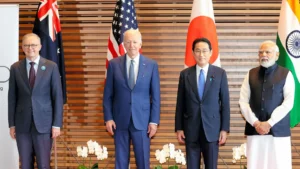
Figure 4 Japanese Prime Minister Fumio Kishida meets with U.S. President Joe Biden and other Group of Seven leaders at NATO Headquarters in Brussels in March. Photo: REUTERS
Burden-sharing will also likely be on the agenda for the US-Japan alliance, as it will for the NATO allies. Already, there are rumors that the NATO commitment to spending 2% of GDP on defense might be raised to 3% in a new Trump administration, again with possible spillover effects for US Indo-Pacific allies. The five-year Host Nation Support agreement between the US and Japan is set to expire in 2027 and thus will need to be renegotiated during the next administration.
But it is likely the larger questions of US strategy under the Trump administration that will be of most concern. Three foreign policy areas are particularly important for Japan. First, US strategy toward China will be of deepest import to Tokyo. Given that Japan has identified China as its gravest strategic threat, Washington’s choices and how much Japan’s interests will be considered in those choices are paramount. Second, how the US decides its role in Ukraine and in the larger context of European security remains to be seen. Japan has committed extensive resources to Ukraine and to the effort to rebuild the nation. Similarly, Japan, like other G7 nations, has imposed sanctions on Russia, drawing retaliation from Moscow. Finally, Japan has a deep stake in the global economy and relies on a free and open global order. A retreat to mercantilist practices would have devastating effects on Japan’s future economic prosperity. Of course, the LDP will face yet another election next year, and Prime Minister Ishiba will have to juggle pressures from within to keep on top of the domestic dynamics at play in Tokyo even as he seeks to ensure a strong US-Japan partnership under a second Trump Administration.
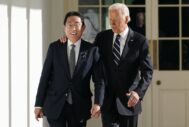
US - Japan
January — April 2024Washington Welcomes Prime Minister Kishida
2024 began with a full agenda for the US and Japan. All eyes were on the January presidential election in Taiwan, and China’s reaction to it. The choice of William Lai Ching-te, who is currently vice president, cemented the hold of the Democratic Progressive Party (DPP) on power, with a third term for the party. Lai has close ties with Japan and has made no bones about his expectation that Japan, as well as the US, will figure prominently in his hopes for Taiwan’s future. The invitation to former Kuomintang (KMT) President Ma Ying-jeou to visit Beijing on April 10 made it clear that Beijing had a different preference than the people of Taiwan. The uptick in Chinese military pressure across the Strait as well as in the South China Sea also concerned the US and Japan. The People’s Liberation Army’s growing demonstration of pressure on Taiwan’s eastern islands continued in the months after Lai’s victory, as Taiwan prepared to inaugurate him as president on May 20. The US and Japan found common cause also in speaking out against China’s growing aggression against Philippine maritime forces at Second Thomas Shoal.
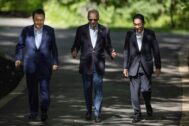
US - Japan
May — August 2023A Busy Diplomatic Calendar for Biden and Kishida
2023 is the year for the US and Japan to intensify their cooperation in multilateral venues. The first opportunity was the G7 meeting in Hiroshima in May, and the last will be the APEC meeting in San Francisco in November. In between, partners were hosting other important meetings: the NATO Summit in Lithuania and the G20 in India. Across these meetings, Russia’s war in Ukraine has stayed at the top of the agenda. The war has focused attention on the rules-based order, but global economic cooperation was not far behind. Prime Minister Kishida Fumio traveled to Africa and the Middle East to offer assistance for food insecurity and to stabilize energy markets, while President Joe Biden reached out to nations in the Indo-Pacific, including Pacific Island nations and Vietnam, to deepen strategic cooperation. China continues to loom large. The Biden administration sent three Cabinet members to Beijing for long sought consultations. Secretary of State Antony Blinken finally realized his planned trip on June 18-19. Secretary of the Treasury Janet Yellen followed on July 6-9 to meet with her counterpart, Vice Premier He Lifeng.
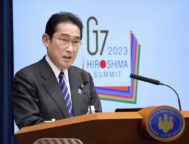
US - Japan
January — April 2023The US and Japan Build Multilateral Momentum
2023 brings a renewed focus on the US-Japan partnership as a fulcrum of global and regional diplomacy. With an eye to the G7 Summit in Hiroshima in mid-May, Prime Minister Kishida Fumio began the year with visits to G7 counterparts in Europe and North America. Later in the spring, he toured Africa in an effort to gain understanding from countries of the Global South. The Joe Biden administration looks ahead to a lively economic agenda, as it hosts the APEC Summit in November on the heels of the G20 Summit in New Delhi in September. National Security Advisor Jake Sullivan laid out in detail the economic ambitions of the Biden national strategy on April 27, giving further clarity to how the administration’s foreign policy will meet the needs of the American middle class. Regional collaboration continues to expand. Both leaders will gather in Australia on May 24 as Prime Minister Anthony Albanese hosts the third in-person meeting of the leaders of the Quad. Also noteworthy in this first quarter of 2023 is the progress in ties between Japan and South Korea.
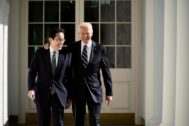
US - Japan
September — December 2022Ramping Up Diplomacy and Defense Cooperation
In the wake of the death of former Prime Minister Abe Shinzo, the fall brought unexpectedly turbulent politics for Prime Minister Kishida Fumio. In the United States, however, President Joe Biden welcomed the relatively positive outcome of the midterm elections, with Democrats retaining control over the Senate and losing less than the expected number of seats in the House. Diplomacy continued to be centered on various impacts of the Russian invasion of Ukraine, but both Biden and Kishida focused their attention on a series of Asian diplomatic gatherings to improve ties. Chinese President Xi Jinping’s attendance at the G20 Meeting in Bali and APEC gathering in Bangkok proffered the opportunity finally for in-person bilateral meetings for both leaders. Finally, Japan’s long awaited strategic documents were unveiled in December. A new National Security Strategy (NSS) took a far more sober look at China’s growing influence and included ongoing concerns over North Korea as well as a growing awareness of Japan’s increasingly difficult relationship with Russia.
Accompanying the NSS is a 10-year defense plan, with a five-year build-up commitment, that gave evidence that Kishida and his ruling coalition were serious about their aim to spend 2% of Japan’s GDP on its security. The desire for greater lethality was also there, with the inclusion of conventional strike investment.

US - Japan
May — August 2022Abe’s Legacy and the Alliance Agenda
It was a busy summer for the United States and Japan. President Joe Biden visited Asia, stopping first in Seoul to meet new South Korean President Yoon Suk Yeol, and then spending two days in Tokyo for a bilateral summit with Prime Minister Kishida Fumio and a follow-on meeting with the two other leaders of the Quad, Indian Prime Minister Narendra Modi and Australia’s newly elected prime minister, Anthony Albanese. Biden announced his Indo-Pacific Economic Framework in Tokyo with Kishida by his side. Economic security legislation in both Japan and the United States revealed the unfolding strategic calculations for the alliance. National efforts to enhance economic productivity and resilience included efforts to ensure reliable supply chains for Japanese and US manufacturers as well as the desire for greater cooperation among the advanced industrial economies to dominate the next generation of technological innovation. State investment in attracting semiconductor suppliers to Japan and the United States demonstrate the urgency with which both governments seek to diminish reliance on critical technology imports.
Despite all the diplomatic planning that accompanied these developments, the summer was not without surprises. In Japan, the sudden death of former Prime Minister Abe Shinzo, at the hand of a lone gunman, shocked a nation known for its relatively low rate of gun violence. Across the globe, leaders praised Abe’s statesmanship and his strategic vision—his ability to meet Japan’s moment of challenge as the rules-based order was under threat.
Only weeks later, the United States and China found themselves in a high-stakes military standoff over Taiwan. US Speaker of the House Nancy Pelosi rescheduled her Asia tour after having to cancel it in April due to COVID-19. Her itinerary leaked, and her intention to visit Taiwan drew China’s ire. A top commentator for the Global Times tweeted that China’s People Liberation Army (PLA) had the right to shoot down Pelosi’s plane if she did. And a highly charged demonstration of Chinese military power ensued. The PLA exercises conducted after her departure directly involved Japan as missiles landed in its exclusive economic zone (EEZ). The United States ensured that its military was close at hand to dissuade miscalculation.
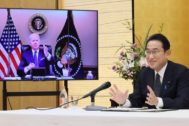
US - Japan
January — April 2022Russian Invasion Accelerates Alliance Review
The US and Japan began the year with a 2+2 meeting, continuing their close coordination on alliance preparedness and regional coalition-building. COVID-19 affected the two allies’ diplomatic schedule, however, as the omicron variant spread quickly in Washington, DC. Once again, an in-person meeting between the secretaries of state and defense and their counterparts, ministers of foreign affairs and defense, had to be moved online. Moreover, resolving the management of COVID by US Forces Japan with Japan’s own protocols was on the agenda. But the US and Japanese governments met another challenge with alacrity: the conclusion of a new Host Nation Support agreement. With an emphasis on alliance resilience, this five-year provision of Japanese support for the US military in Japan handily sidestepped some of the political difficulties that have colored talks in the past.
Much is ahead for Japan this year in updating its strategic planning. Prime Minister Kishida Fumio began a strategic review late last year, and the National Security Council as well as the Ministry of Defense got to work on laying out the aims of a new National Security Strategy, 10-year defense plan, and an accompanying procurement plan. Shaped by the accelerating shift in the military balance in Japan’s vicinity and across the Indo-Pacific, this strategic review is expected to be momentous. The Liberal Democratic Party (LDP) also initiated its own study of Japan’s strategic needs and produced a draft that highlights doubling Japan’s defense spending to match NATO’s target of 2% of GDP.
But President Biden and Prime Minister Kishida have focused on Europe since Russia invaded Ukraine. Both allies have been in sync as the G7 mobilized to impose sanctions against Russia and aid to Ukraine. Framing this crisis as a violation of the postwar international order, Kishida firmly committed Japan to ongoing and comprehensive engagement with not only the US but also European nations. Moreover, Putin’s war against Ukraine has galvanized dialogue between US allies in NATO and in Asia, creating a deepening diplomatic opportunity for Japan to develop European support should a similar crisis erupt in the Indo-Pacific.
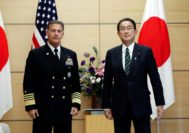
US - Japan
September — December 2021A New Prime Minister and a Growing Alliance Agenda
2021 demonstrated the difficult politics that have attended the COVID-19 pandemic. In the United States, the Congressional certification of the presidential election became the focus of violent protest and an attempted insurrection to stop the transfer of power from Donald Trump to Joseph Biden. In Japan, while less volatile, the post-Abe era revealed the fragile balance of power within the Liberal Democratic Party (LDP) that threatened to unseat unpopular prime ministers. The year began with Prime Minister Suga Yoshihide but ended with Prime Minister Kishida Fumio as Suga’s public approval ratings plummeted in response to the government’s pandemic management and the troublesome Tokyo Olympics. Japan’s two elections, one for the leadership of the LDP and the other for the Lower House, revealed just how sticky conservative politics are today. Undoubtedly, the election within the party drew the most interest as four new candidates emerged to claim the mantle of leadership of Japan’s largest political party.
Kishida emerged victorious after a second round of voting, which privileged those in the Diet over the rank and file of the party, with a far more assertive stance on Japan’s strategic outlook. He then led his party to victory in the general election, overcoming an opposition coalition that continued to struggle to put forward a cohesive identity or policy agenda.
Diplomatically, Washington and Tokyo continued to focus on their Indo-Pacific cooperation. The two militaries have continued consultations on how to cope with China’s growing presence in and around Japan’s southwestern islands. A new prime minister offered opportunity to further define the scope of US-Japan cooperation, and a new Biden-Kishida agenda is in the works. COVID-19 again intervened to prevent in-person meetings, but a virtual US-Japan 2+2 meeting allowed for continued alliance problem-solving.
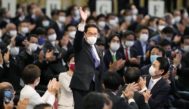
ROUNDTABLE
November 3, 2021Japan’s Elections and its Foreign Relations

US - Japan
May — August 2021Summer Takes an Unexpected Turn
By the end of spring, the US-Japan relationship was centerstage in the Biden administration’s Indo-Pacific diplomacy. From the first Quad (virtual) Summit to the visit of Prime Minister Suga Yoshihide to Washington, DC, relations between Tokyo and Washington could not have been better. A full calendar of follow-up meetings for the fall suggested even further deepening of the partnership. And on Aug. 20, President Joe Biden announced that he intended to nominate Rahm Emanuel, former mayor of Chicago and chief of staff for President Obama, as ambassador to Japan. Throughout the summer, the US and Japan continued to deepen and expand the global coalition for Indo-Pacific cooperation. The UK, France, and even Germany crafted their own Indo-Pacific visions, as did the EU. Maritime cooperation grew as more navies joined in regional exercises. Taiwan featured prominently in US-Japan diplomacy, and in May the G7 echoed US-Japan concerns about rising tensions across the Taiwan Straits. Japanese political leaders also spoke out on the need for Japan to be ready to support the US in case tensions rose to the level of military conflict.